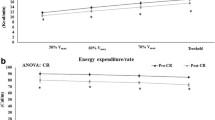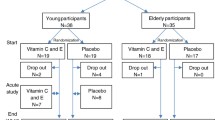Abstract
A matched-pair trial under near double-blind conditions has tested the physiological effects of an 85-day-course of d-α tocopherol acid succinate (1200 I.U./day) in 20 university class swimmers. Valid comparisons were possible in 7 of the 10 pairs. These showed good initial matching of maximum oxygen intake, recovery curves, muscle strength and e.c.g. waveform. Despite a substantial yardage of swimming training (∼ 20,000 yards/week), neither test nor control groups improved their aerobic power. However, both groups showed a reduction in the lactate component of the oxygen debt, with a faster pulse recovery curve. Muscle strengths tended to decline, the loss of handgrip strength being significant in the control group. No change of e.c.g. waveform was observed except a small increase of T wave height in the controls. It is concluded that the swimmers gained no advantage from the Vitamin E, although it could conceivably have helped maintain equality of status in the face of a slightly smaller weekly yardage than that of the control group.
Similar content being viewed by others
References
Chadd, M. A., Fraser, A. J.: Vitamin E deficiency in premature infants. Int. J. Vit. Res. 40, 604–609 (1971)
Consolazio, C. F., Matoush, L. R. O., Nelson, R. A., Isaac, G. J., Hursh, L. M.: Effect of octacosanol, wheat germ oil, and Vitamin E in performance of swimming rats. J. appl. Physiol. 19, 265–267 (1964)
Cureton, T. K.: Effect of wheat germ oil and Vitamin E on normal human subjects in physical training programs. Amer. J. Physiol. 179, 628 (1954)
Darlington, F. G., Chassels, J. B.: A study on the breeding and racing of thoroughbred horses given large doses of α tocopherol. The Summary 8, 1–25 (1965)
Holman, R. L.: Prevention of experimental arteritis in dogs by Vitamin E. Proc. Soc. exp. Biol. (N.Y.) 66, 307–309 (1947)
Hove, E. L., Hickman, K. C. D., Harris, P. L.: The effect of α tocopherol and of fat on the resistance of rats to acute anoxia. Arch. Biochem. Biophys. 8, 395–404 (1945)
Kamimura, M., Takahashi, S.: Region of skin micro-circulation in which Vitamin E acts. Studies on skin temperature and blood volume. J. Vitaminol. 12, 274–280 (1966)
Kamimura, M., Takahashi, S., Henmi, I.: On the influence of Vitamin E in the low oxygen tolerance of mice. Sapporo med. J. 21, 71–77 (1962)
Legge, R. F.: Resolving the Vitamin E controversy. Canad. Research and Development 1–11, Sept./Oct. (1971)
Leonard, P. J., Losowsky, M. S.: Effect of alpha-tocopherol administration on red cell survival in Vitamin E deficient human subjects. Amer. J. clin. Nutr. 24, 388–393 (1971)
MacCarl, N.: Vitamin E credited as Leaf flag tonic — capsules helped Goliat and other vets. The Sporting News (St. Louis) 142 (19), Dec. (1956)
Mayer, J., Bullen, B.: Nutrition and athletic performance. Physiol. Rev. 40, 369–397 (1960)
Nayar, H. S.: Load carriage, physical efficiency, and Vitamin E. Indian J. Physiol. Pharmacol. 8, 49–52 (1964)
Nichoalds, G. E., Jones, R. R., Diehl, J. F., Fitch, C. D.: Vitamin E deficiency and the accumulation of amino-acids in skeletal muscle. J. Nutr. 99, 27–33 (1969)
Percival, L.: Vitamin E in athletic efficiency (preliminary report). The Summary 3, 55–64 (1951)
Prokop, L.: Die Wirkung von natürlichem Vitamin E auf Sauerstoffverbrauch und Sauerstoffschuld. Sportärztl. Prax. 1, 19–23 (1960)
Sakaeva, E. A., Efremov, V. V.: Opyt dopolnitel'nogo naznachenia vitamina e sportsmenam velogonschikam i lyzhnikam (exercise and Vitamin E in cyclists and skiers). Vestn. Akad. med. Nauk 27, 52–55 (1972)
Sandstead, H. H., Gabr, M. K., Azzam, S., Shuky, A. S., Weiler, R. J., El Din, D. M., Mokhter, N., Prasad, A. S., El Hifney, A., Darby, W. J.: Kwashikor in Egypt. II. Hematologic aspects (the occurrence of a macrocytic anemia associated with low vitamin E levels and a wide range of serum vitamin B12 levels). Amer. J. clin. Nutr. 17, 27–35 (1965)
Sharman, I. M., Down, M. G., Sen, R. N.: The effects of Vitamin E on physiological function and athletic performance in adolescent swimmers. Brit. J. Nutr. 26, 265–276 (1971)
Shephard, R. J., Allen, C., Benade, A. J. S., Davies, C. T. M., di Prampero, P. E., Hedman, R., Merriman, J. E., Myhre, K., Simmons, R.: The maximum oxygen intake — an international reference standard of cardio-respiratory fitness. Bull. Wld Hlth Org. 38, 757–764 (1968)
Shephard, R. J., Campbell, R., Pimm, P., Stuart, D., Wright, G. R.: Vitamin E for swimmers? The Physician and Sports Medicine (in press, 1974)
Shute, E. V.: Vitamin E for athletes. Paper presented to First International Congress of Swimming coaches in Montreal, and reprinted in: The Summary, Dec. (1971)
Shute, E. V.: The Summary 3, 77 (1951); cit. by Sharman et al., op. cit.
Thomas, P.: The effects of Vitamin E on some aspects of athletic efficiency. Thesis University of S. Calif., Los Angeles (1957)
Vaccari, F.: Cuore e Circol. 35, 3 (1951); cit. by Shute, E. V., in: Vitamin E for athletes. The Summary 23, 3–9, Dec. (1971)
West, W. T., Mason, K. E.: Histopathology of muscular dystrophy in the Vitamin E-deficient hamster. Amer. J. Anat. 102, 323–349 (1958)
Author information
Authors and Affiliations
Additional information
The increased survival could equally reflect an anti-oxidant effect with a decrease of resting metabolism.
Rights and permissions
About this article
Cite this article
Shephard, R.J., Campbell, R., Pimm, P. et al. Vitamin E, exercise, and the recovery from physical activity. Europ. J. Appl. Physiol. 33, 119–126 (1974). https://doi.org/10.1007/BF00449513
Received:
Issue Date:
DOI: https://doi.org/10.1007/BF00449513




